Bio Exam Questions 2
5.0(1)
Card Sorting
1/49
Earn XP
Description and Tags
Study Analytics
Name | Mastery | Learn | Test | Matching | Spaced |
|---|
No study sessions yet.
50 Terms
1
New cards

The annelid worms pictured below weigh 6.0 grams each. Like other Annelida, Tomopteris and Ochetostoma obtain oxygen for respiration via diffusion across their external surfaces. Based on what you can see in the photos, which worm has the higher maximum oxygen uptake potential?
a. Ochetostoma
b. Tomopterous
a. Ochetostoma
b. Tomopterous
b. Tomopterous
2
New cards

The figure below shows the life history of a _________________ like SARs-CoV-2.
a. RNA virus
b. RNA retrovirus
c. DNA virus
a. RNA virus
b. RNA retrovirus
c. DNA virus
a. RNA virus
3
New cards

The Missouri saddled darter Etheostoma tetrazonum and the variegated darter Etheostoma variatum share a common ancestor. Their once shared genetic lineage diverged during the Pleistocene when their respective sublineages became isolated by an advancing glacier. _____________ speciation occurred following this _________________ event.
a. allopatric, stabilizing selection
b. sympatric, vicariance
c. allopatric, vicariance
d. allopatric, mutation
e. sympatric, stabilizing selection
a. allopatric, stabilizing selection
b. sympatric, vicariance
c. allopatric, vicariance
d. allopatric, mutation
e. sympatric, stabilizing selection
c. allopatric, vicariance
4
New cards

The figure below illustrates a process during which the bacterial cell on the left ruptures and some of its DNA is taken up from the external medium by another cell which then incorporates it into its genome. This process is termed __________.
Select one:
a. vertical transfer
b. transformation
c. conjugation
d. transduction
Select one:
a. vertical transfer
b. transformation
c. conjugation
d. transduction
b. transformation
5
New cards
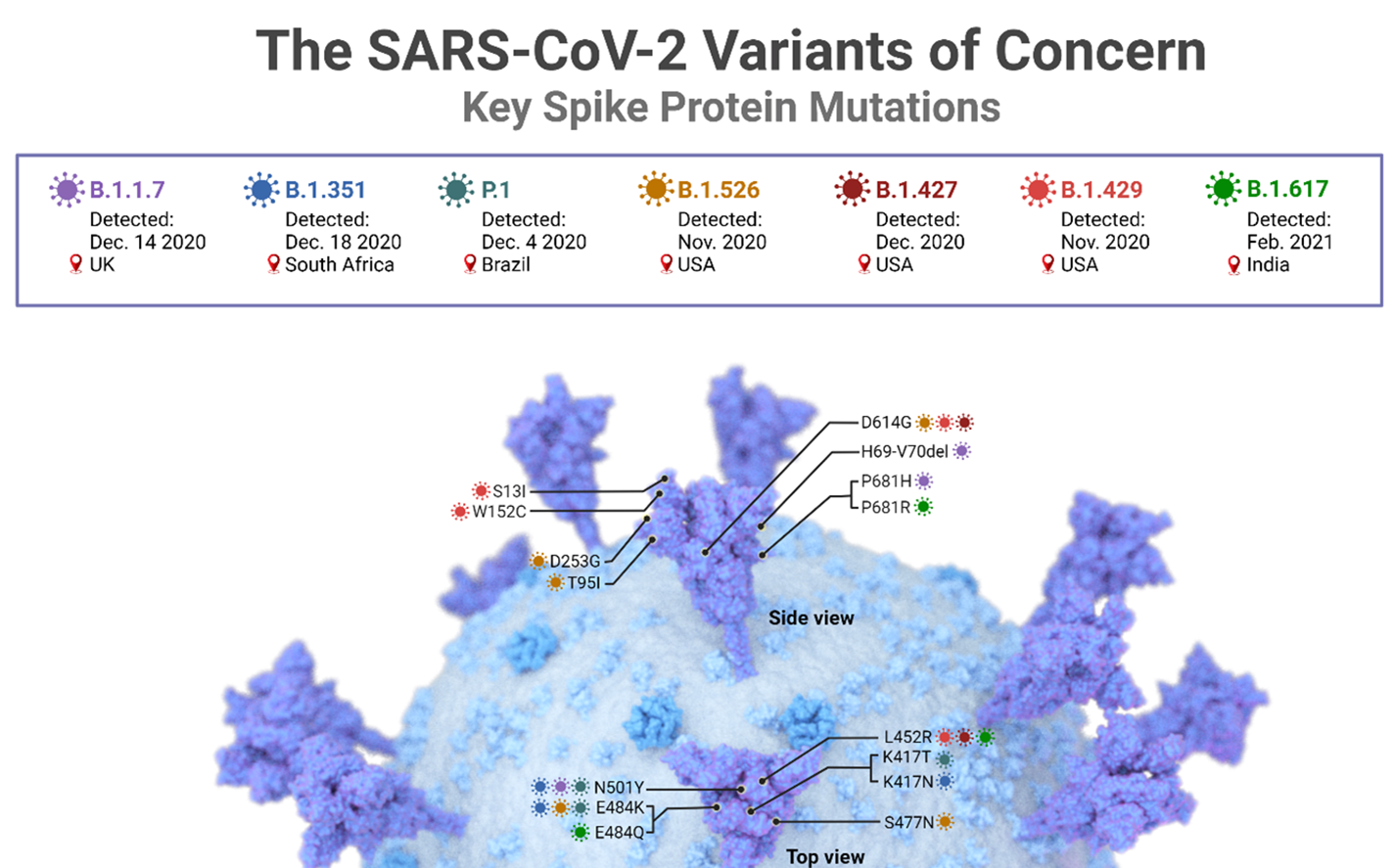
The figure below shows numerous spike protein variants of SARS-CoV-2. These variants are of great concern because they have increased abilities to enter cells via _______________.
a. receptor-mediated endocytosis
b. phagocytosis
c. pinocytosis
a. receptor-mediated endocytosis
b. phagocytosis
c. pinocytosis
a. receptor-mediated endocytosis
6
New cards
The probability of lineage persistence (avoiding extinction) in a rapidly changing environment ____ with increasing genetic variance.
Select one:
a. increases
b. does not change
c. decreases
decreases
Select one:
a. increases
b. does not change
c. decreases
decreases
a. increases
7
New cards
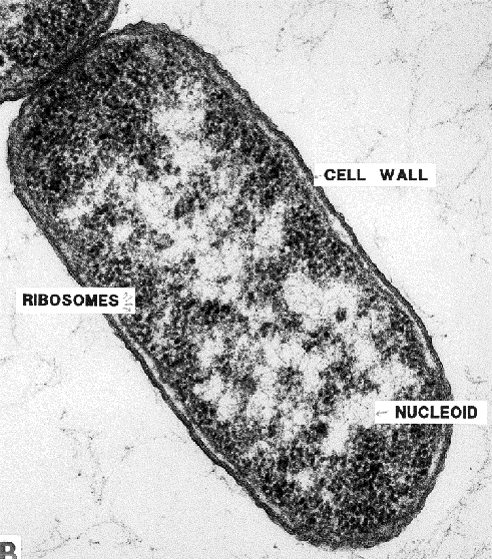
It is apparent from the micrograph below that the ribosomes account for much of the biomass of a bacterial cell. Why is this the case?
Select one:
a.
Ribosomes serve a critical protective function in the cell. They surround the nucleoid which protects this valuable region from exposure to ultraviolet radiation and environmental toxins.
b.
As the site of protein synthesis, ribosomes produce the structural proteins required to build and replicate cells and the enzymes required for life to proceed.
c.
Ribosomes store DNA and the more complex a cell is, the more DNA is required. Thus a large portion of the intercellular space is often filled by ribosomes in complex cells.
Select one:
a.
Ribosomes serve a critical protective function in the cell. They surround the nucleoid which protects this valuable region from exposure to ultraviolet radiation and environmental toxins.
b.
As the site of protein synthesis, ribosomes produce the structural proteins required to build and replicate cells and the enzymes required for life to proceed.
c.
Ribosomes store DNA and the more complex a cell is, the more DNA is required. Thus a large portion of the intercellular space is often filled by ribosomes in complex cells.
b. As the site of protein synthesis, ribosomes produce the structural proteins required to build and replicate cells and the enzymes required for life to proceed.
8
New cards
________________ factors are _____________involved in the process of converting DNA into RNA.
a. Transcription, proteins
b. Transcription, nucleic acids
c. Translation, prions
d. Transcription, lipids
e. Translation, nucleic acids
a. Transcription, proteins
b. Transcription, nucleic acids
c. Translation, prions
d. Transcription, lipids
e. Translation, nucleic acids
a. Transcription, proteins
9
New cards
In the world of very low Reynold’s number organisms like bacteria in lake water, the power of _______________.
a.
inertial forces exceed the power of viscous forces
b.
viscous forces exceed the power of inertial forces
c.
viscous forces and inertial forces are perfectly balanced
a.
inertial forces exceed the power of viscous forces
b.
viscous forces exceed the power of inertial forces
c.
viscous forces and inertial forces are perfectly balanced
b. viscous forces exceed the power of inertial forces
10
New cards

Select the correct interpretation of this figure which shows the relationship between human swimming speeds in high and low viscosity solutions.
a. Isaac Newton was correct. High viscosity slowed the swimming speeds (relative to swimming in water) of high Reynold’s number organisms.
b.
Isaac Newton was incorrect. High viscosity increased the swimming speeds of low Reynold’s number organisms.
c.
Isaac Newton was incorrect. The influence of the viscosity in the guar gum filled pool resulted in little difference in the swimming speeds of high Reynold’s number organisms in high viscosity solutions relative to speeds in low viscosity (water) solutions.
d.
Isaac Newton was incorrect. The influence of the viscosity in the guar gum filled pool resulted in little difference in the swimming speeds of low Reynold’s number organisms in high viscosity solutions relative to speeds in low viscosity (water) solutions.
a. Isaac Newton was correct. High viscosity slowed the swimming speeds (relative to swimming in water) of high Reynold’s number organisms.
b.
Isaac Newton was incorrect. High viscosity increased the swimming speeds of low Reynold’s number organisms.
c.
Isaac Newton was incorrect. The influence of the viscosity in the guar gum filled pool resulted in little difference in the swimming speeds of high Reynold’s number organisms in high viscosity solutions relative to speeds in low viscosity (water) solutions.
d.
Isaac Newton was incorrect. The influence of the viscosity in the guar gum filled pool resulted in little difference in the swimming speeds of low Reynold’s number organisms in high viscosity solutions relative to speeds in low viscosity (water) solutions.
c. Isaac Newton was incorrect. The influence of the viscosity in the guar gum filled pool resulted in little difference in the swimming speeds of high Reynold’s number organisms in high viscosity solutions relative to speeds in low viscosity (water) solutions.
11
New cards
Bacteria in aqueous solutions exist in a state in which they are continuously bombarded by molecules as they course through the surrounding medium. The characteristic erratic movement of bacteria and other microscopic particles that results from this constant molecular pelting is termed __________.
Select one:
a. flagellar propulsion
b. Brownian motion
c. cytoplasmic streaming
d. diffusive transport
e. Einstein's Tanzen
Select one:
a. flagellar propulsion
b. Brownian motion
c. cytoplasmic streaming
d. diffusive transport
e. Einstein's Tanzen
b. Brownian motion
12
New cards
Which form of selection is most likely to result in speciation?
Select one:
a. stabilizing
b. Mendelian
c. directional
d. diversifying
Select one:
a. stabilizing
b. Mendelian
c. directional
d. diversifying
d. diversifying
13
New cards

The Spanish flu pandemic of 1918, the deadliest in history, infected an estimated 500 million people worldwide. This virus, which is pictured below, is a variant known as H1N1. The H and N refer to the _________.
Select one:
a.
surface lipid helicase and membrane energizing enzyme niacin
b.
surface protein hemagglutinin and membrane cleaving enzyme neuraminidase
c.
surface energizing carbohydrates helicose and variants of n-acetyl ribose molecules
d.
surface nucleotide hemiguanine and membrane cleaving enzyme nicotinamide
Select one:
a.
surface lipid helicase and membrane energizing enzyme niacin
b.
surface protein hemagglutinin and membrane cleaving enzyme neuraminidase
c.
surface energizing carbohydrates helicose and variants of n-acetyl ribose molecules
d.
surface nucleotide hemiguanine and membrane cleaving enzyme nicotinamide
b. surface protein hemagglutinin and membrane cleaving enzyme neuraminidase
14
New cards

The photo below shows a researcher's pipette drawing in a human stem cell for a CRISPR-Cas9 gene editing experiment. Why are embryonic stem cells preferred for this kind of research?
a.
Due to their totipotency, embryonic stem cells can only differentiate into the few important cell types that are of interest when editing embryonic genomes.
b.
embryonic stem cells only make baby cells so editing experiments will not affect the adult phenotype.
c.
Due to their totipotency, embryonic stem cells can produce all cell types that occur in later developmental stages.
d.
Because they are multipotent, embryonic stem cells are ideal for gene editing research.
a.
Due to their totipotency, embryonic stem cells can only differentiate into the few important cell types that are of interest when editing embryonic genomes.
b.
embryonic stem cells only make baby cells so editing experiments will not affect the adult phenotype.
c.
Due to their totipotency, embryonic stem cells can produce all cell types that occur in later developmental stages.
d.
Because they are multipotent, embryonic stem cells are ideal for gene editing research.
c. Due to their totipotency, embryonic stem cells can produce all cell types that occur in later developmental stages.
15
New cards
In biology, the Greek word root troph which means __________is used in various terms including trophic.
a. defend; maintain
b. advance; move
c. persist; hold
d. regulate; govern
e. nourish; food
a. defend; maintain
b. advance; move
c. persist; hold
d. regulate; govern
e. nourish; food
e. nourish; food
16
New cards
For gene acquisition via transformation to take place, the recipient bacteria cell must be _____.
Select one:
a. a different sex than the donor
b. closely related to the donor
c. an F-minus phenotype
d. in a state of competence
Select one:
a. a different sex than the donor
b. closely related to the donor
c. an F-minus phenotype
d. in a state of competence
d. in a state of competence
17
New cards
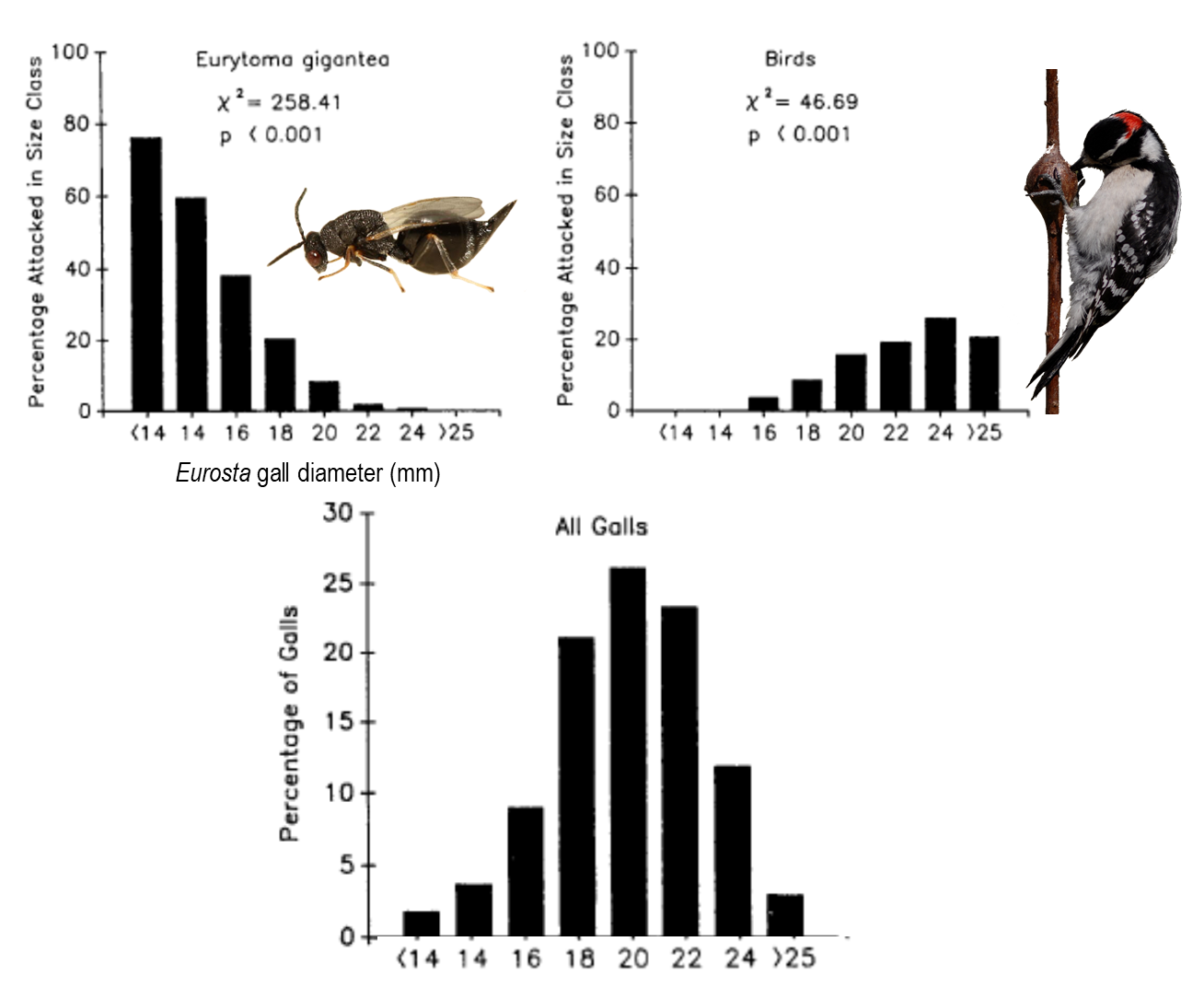
The data below show a classic example of ________________________ selection.
a. directional
b. diversifying
c. stabilizing
a. directional
b. diversifying
c. stabilizing
c. stabilizing
18
New cards
Gene duplication provides the raw genetic material for the evolution of many, if not most, new genes. In cases where adaptive outcomes have occurred, gene duplication is thought _______________________.
a.
to have wiped both potentially deleterious copies out of the genome due to fertility issues experienced by the mutant forms
b.
to have resulted in one copy maintaining the ancestral function while the other acquired a novel function via mutation
c.
that the new copy deteriorated and become a pseudogene, while the parental copy remained unchanged.
d.
to have produced two functional copies which allowed for twice as much adaptive potential to be subject to selection
a.
to have wiped both potentially deleterious copies out of the genome due to fertility issues experienced by the mutant forms
b.
to have resulted in one copy maintaining the ancestral function while the other acquired a novel function via mutation
c.
that the new copy deteriorated and become a pseudogene, while the parental copy remained unchanged.
d.
to have produced two functional copies which allowed for twice as much adaptive potential to be subject to selection
b. to have resulted in one copy maintaining the ancestral function while the other acquired a novel function via mutation
19
New cards

The genetic basis of the recessive white color in the spirit bear is a single nucleotide change from G to A, resulting in the replacement of Tyr to Cys at codon 298 in themelanocortin 1 receptor gene (mc1r). From this information you should be able to discern that the cub shown with her mother in the photo below is _____________ at the locus for gene mc1r.
a. heterozygous
b. homozygous
a. heterozygous
b. homozygous
a. heterozygous
20
New cards

The micrograph below shows cells engaging in ______ gene transfer via _____.
Select one:
a. horizontal, transduction
b. horizontal, conjugation
c. vertical, transformation
d. vertical, conjugation
e. horizontal, transformation
f. vertical, transduction
Select one:
a. horizontal, transduction
b. horizontal, conjugation
c. vertical, transformation
d. vertical, conjugation
e. horizontal, transformation
f. vertical, transduction
b. horizontal, conjugation
21
New cards
A main function of enzymes in biochemical reactions is to ____.
Select one:
a.
increase the energy required to make chemical bonds
b.
lower the activation energy required for a reaction to proceed
c.
lock up available substrates making them less available to potential competitors
Select one:
a.
increase the energy required to make chemical bonds
b.
lower the activation energy required for a reaction to proceed
c.
lock up available substrates making them less available to potential competitors
b. lower the activation energy required for a reaction to proceed
22
New cards
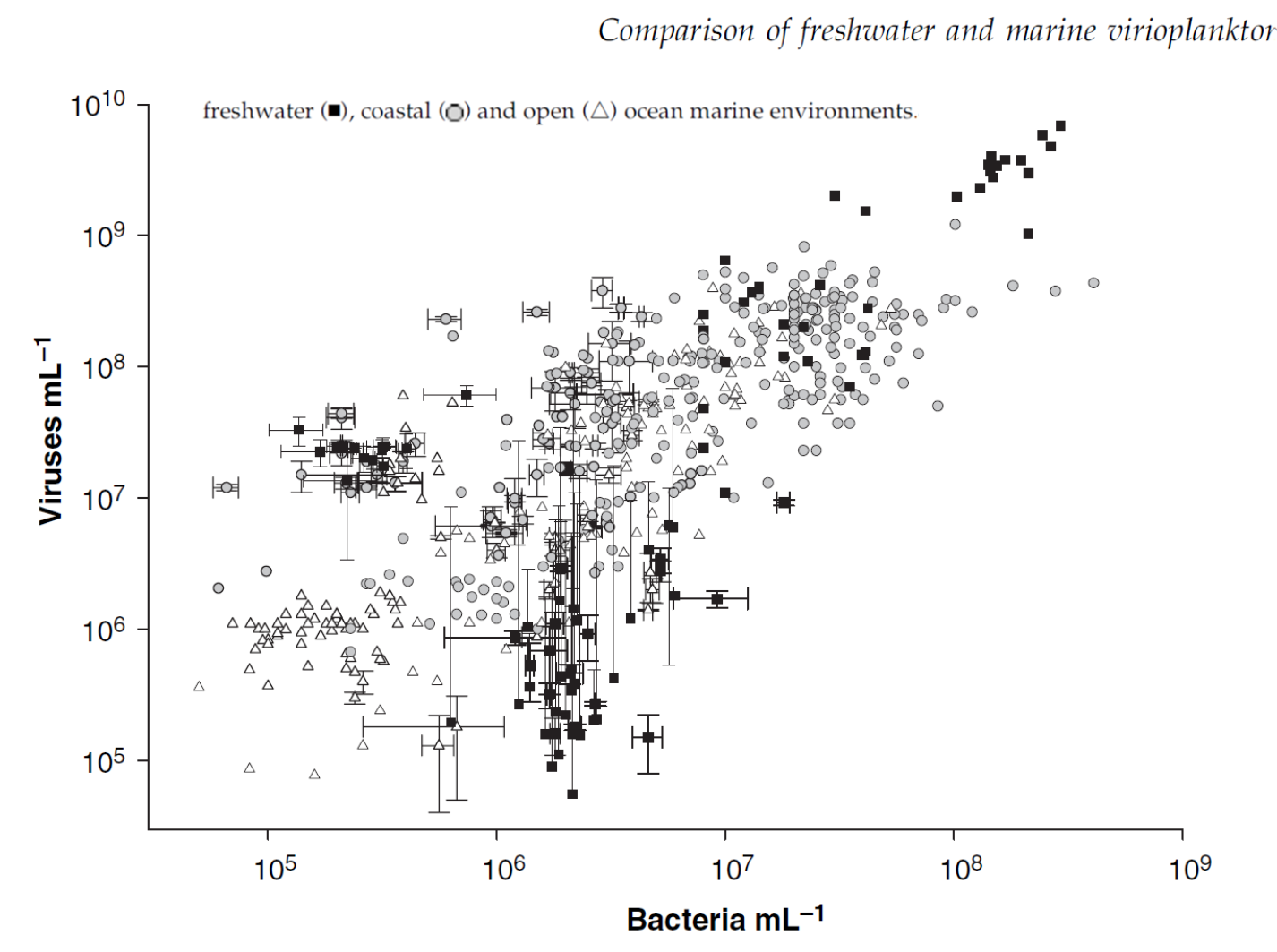
The figure below shows that bacteriophage abundance is usually approximately ___________ than the abundance of bacteria cells. A particularly obvious example of this relationship can be seen in eutrophic freshwater systems.
a. 100 times higher
b. 10 times lower
c. 10 times higher
d. 100 times lower
e. 1000 times higher
a. 100 times higher
b. 10 times lower
c. 10 times higher
d. 100 times lower
e. 1000 times higher
c. 10 times higher
23
New cards

The genetic basis of the recessive white color in the spirit bear is a single nucleotide change from G to A, resulting in the replacement of Tyr to Cys at codon 298 in themelanocortin 1 receptor gene (mc1r). One of the bears on the left was the father of the cub shown with its mother on the right. Which one was it?
a. Bear A
b. It could be either A or B. It's impossible to tell by looking at their fur color
c. Bear B
a. Bear A
b. It could be either A or B. It's impossible to tell by looking at their fur color
c. Bear B
b. It could be either A or B. It's impossible to tell by looking at their fur color
24
New cards

The Red Queen hypothesis draws an analogy between Lewis Carroll's red queen and the process of __________________________.
a. stabilizing selection
b. sympatric speciation
c. coevolution
d. allopatric speciation
e. convergent evolution
a. stabilizing selection
b. sympatric speciation
c. coevolution
d. allopatric speciation
e. convergent evolution
c. coevolution
25
New cards
Due to the actions of ______________________ CRISPR-Cas occurs in ~50% of sequenced Bacteria genomes and ~90% of Archaea.
a. phages
b. fungi
c. infectious protists
d. environmental gradients
a. phages
b. fungi
c. infectious protists
d. environmental gradients
a. phages
26
New cards
When a misfolded ___________ protein enters a healthy organism, it induces properly-folded proteins to convert into misfolded, infectious disease-associated forms.
a. gene editing
b. bacteriophage
c. prion
d. leucocyte
e. transducer
a. gene editing
b. bacteriophage
c. prion
d. leucocyte
e. transducer
c. prion
27
New cards

The image below shows the life cycle of a _______________________.
a. RNA virus
b. DNA virus
c. methanogenic Archaea strain
d. RNA retrovirus
e. pathogenic E. coli strain
a. RNA virus
b. DNA virus
c. methanogenic Archaea strain
d. RNA retrovirus
e. pathogenic E. coli strain
b. DNA virus
28
New cards

Which of the figures below shows the cell size response observed in an experiment testing the effects of increasing concentrations of the antibiotic fosfomycin on bacteria cell size? Note that the size change increased resistance to the antibiotic.
Select one:
a. I
b. II
c. neither set of figure shows a typical cell size response to antibiotics
Select one:
a. I
b. II
c. neither set of figure shows a typical cell size response to antibiotics
a. I
29
New cards

The time-lapse images below show a mouse white blood cell capturing and engulfing a human red blood cell. This beautifully depicted immune response event provides an excellent example of __________________.
a. receptor mediated endocytosis
b. phagocytosis
c. pinocytosis
a. receptor mediated endocytosis
b. phagocytosis
c. pinocytosis
b. phagocytosis
30
New cards
A ___________ phage infection begins with a ________________ event where the phage DNA maintains itself in the host as a prophage.
a. lysogenic (temperate), transduction
b. lytic (virulent), translation
c. lytic (virulent), transduction
d. lysogenic (temperate), translation
a. lysogenic (temperate), transduction
b. lytic (virulent), translation
c. lytic (virulent), transduction
d. lysogenic (temperate), translation
a. lysogenic (temperate), transduction
31
New cards
The genomes of almost all angiosperms (flowering plants) as well as those of many other organisms show evidence of multiple occurrences of a type of mutation where whole chromosomes are duplicated. The resultant genotypic condition is termed _____________.
Select one:
a. haploploidy
b. diploploidy
c. hoidyploidy
d. polyploidy
Select one:
a. haploploidy
b. diploploidy
c. hoidyploidy
d. polyploidy
d. polyploidy
32
New cards

The figures below depict the results of a classic study on the effects of predators (birds) and parasitoids (Eurytoma gigantea) on goldenrod ball gall size. Because gall size and the feeding rate of the gall-inducing fruit fly larva (Eurosta solidaginis) are positively correlated, these results suggest that natural selection favors ___________feeding rates when Eurytoma and gall fly eating birds are present.
a. fast
b. slow
c. moderate
d. all
a. fast
b. slow
c. moderate
d. all
c. moderate
33
New cards
Diachasma alloeum is a parasitoid wasp that lays its eggs on Rhagoletis pommonella larvae. Both species have diverged into subspecies through a host shift by part of the R. pommonella population from hawthorn to apple. Like R. pommonella, D. alloeum has diverged into subspecies with the newly evolved subspecies parasitizing the newly evolved subspecies of R. pommonella that feeds on apples. Researchers suggest that the divergence and subsequent reproductive isolation of these species is evidence of _____ speciation in progress.
Select one:
a. allopatric
b. synthetic
c. autopatric
d. sympatric
e. parapatric
Select one:
a. allopatric
b. synthetic
c. autopatric
d. sympatric
e. parapatric
d. sympatric
34
New cards
CRISPR (Clustered Regularly Interspaced Short Palindromic Repeats) is a gene editing technology that was developed from a genetic program thought to have originated as ______.
Select one:
a.
genes that originated in the common ancestor to all life, which allows CRISPR to be used on all organisms without fear of rejection
b.
the first eukaryotic genes that code for genome doubling mutations
c.
phage inserted genes that protected recipient prokaryotic cells from future phage attacks by facilitating identification and removal of other foreign DNA
d.
bacterial genes for DNA repair proteins in Archaea cells
Select one:
a.
genes that originated in the common ancestor to all life, which allows CRISPR to be used on all organisms without fear of rejection
b.
the first eukaryotic genes that code for genome doubling mutations
c.
phage inserted genes that protected recipient prokaryotic cells from future phage attacks by facilitating identification and removal of other foreign DNA
d.
bacterial genes for DNA repair proteins in Archaea cells
c. phage inserted genes that protected recipient prokaryotic cells from future phage attacks by facilitating identification and removal of other foreign DNA
35
New cards

The egg pictured below is covered with sperm cells. The egg and sperm were produced by two different species. This potential hybrid event failed due to surface chemical features of the egg that prevent sperm from completing fertilization. This is an example of _________________.
a. postzygotic isolation
b. behavioral isolation
c. sympatric isolation
d. allopatric isolation
e. prezygotic isolation
a. postzygotic isolation
b. behavioral isolation
c. sympatric isolation
d. allopatric isolation
e. prezygotic isolation
e. prezygotic isolation
36
New cards
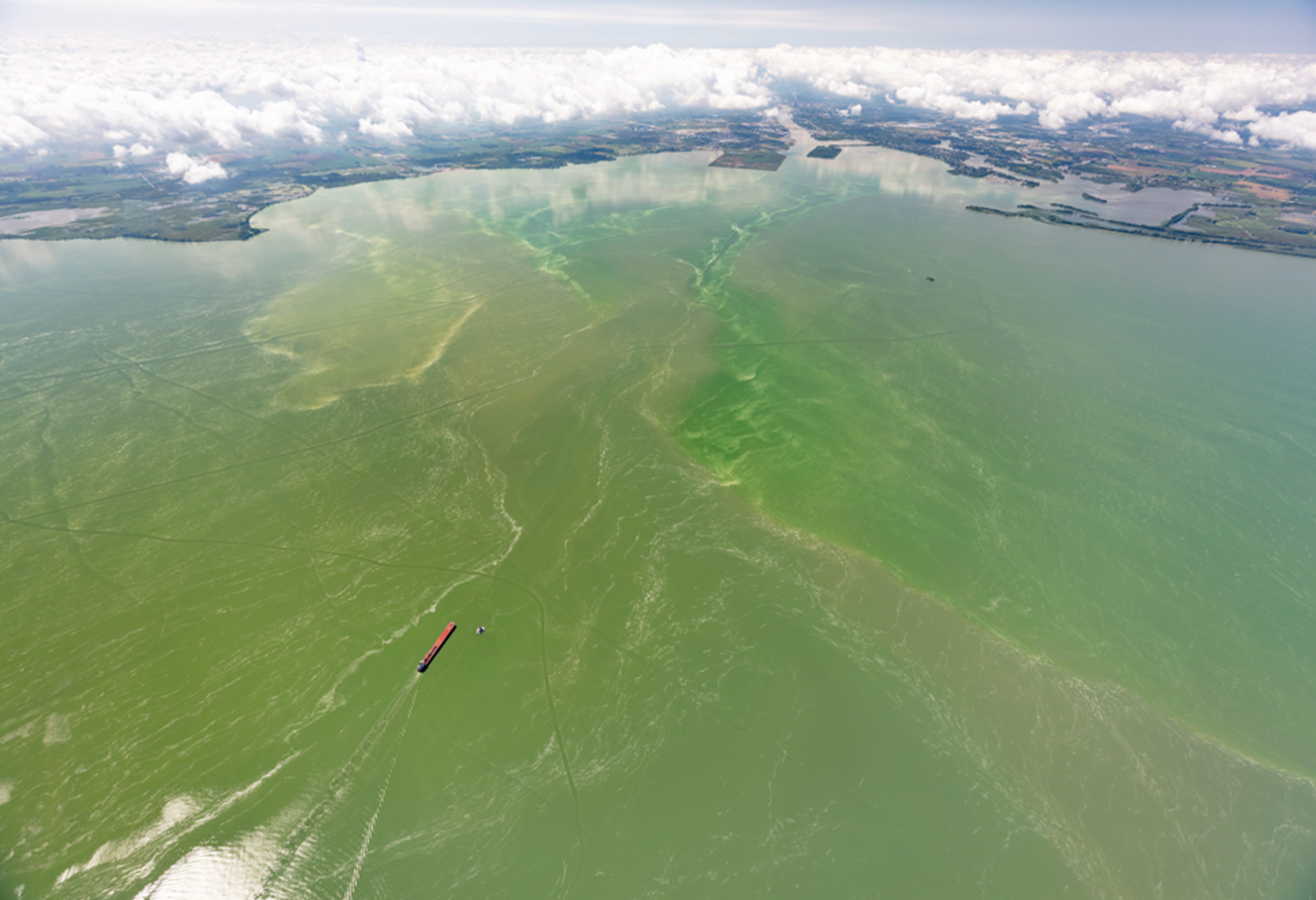
The photo below shows the mouth of the Maumee River from above Lake Erie. For spatial perspective, the red object is a freighter moving toward the mouth. The nutrient-laden river waters have caused the massive algal bloom in the lake. As dead algal cells sink to the lake bottom, respiration by decomposer bacteria draw dissolved oxygen concentrations down to very low levels. These conditions favor _________________ selection toward increasingly ____________ cell size in bacteria populations as dissolved oxygen concentrations decline.
a. stabilizing, fluctuating
b. directional, smaller
c. directional, larger
a. stabilizing, fluctuating
b. directional, smaller
c. directional, larger
b. directional, smaller
37
New cards

The process depicted below, wherein a gene goes from a “closed” state to an “open” state that allows it to be transcribed, is an example of a/an__________ change in gene expression.
a. mutational
b. recessive
c. dominant
d. epigenetic
e. inconsequential
a. mutational
b. recessive
c. dominant
d. epigenetic
e. inconsequential
d. epigenetic
38
New cards
Which mode of selection decreases genetic diversity within a population?
Select one:
a. stabilizing selection
b. behavioral selection
c. diversifying selection
d. directional selection
Select one:
a. stabilizing selection
b. behavioral selection
c. diversifying selection
d. directional selection
a. stabilizing selection
39
New cards

The figure below shows that abundance of bacteria in open ocean habitats is generally ____________ than coastal marine bacteria abundance. This is because coastal habitats are generally more ___________ than open ocean habitats.
a. lower, oligotrophic
b. lower, eutrophic
c. greater, eutrophic
d. greater, oligotrophic
a. lower, oligotrophic
b. lower, eutrophic
c. greater, eutrophic
d. greater, oligotrophic
b. lower, eutrophic
40
New cards

It is apparent that the cell in the micrograph below is a prokaryote due to the presence of _____, which is a common characteristic of all prokaryotes.
Select one:
a. ribosomes
b. a cell wall comprised (in part) of peptidoglycan
c. a nucleoid region
Select one:
a. ribosomes
b. a cell wall comprised (in part) of peptidoglycan
c. a nucleoid region
c. a nucleoid region
41
New cards

The average cell volume of the three bacteria species in the figure below is approximately the same. Which one has the largest average surface area to volume ratio (SA:V)?
Select one:
A
C
They all have the same SA/V
B
Select one:
A
C
They all have the same SA/V
B
C
42
New cards

The images below depict __________________ and the garden where he conducted pioneering breeding experiments in the field we now call _____________.
a. Gregor Mendel, environmental toxicology
b. Alfred Russel Wallace, biogeography
c. Charles Darwin, genetics
d. Gregor Mendel, genetics
e. Charles Darwin, ecology
a. Gregor Mendel, environmental toxicology
b. Alfred Russel Wallace, biogeography
c. Charles Darwin, genetics
d. Gregor Mendel, genetics
e. Charles Darwin, ecology
d. Gregor Mendel, genetics
43
New cards

Coevolution can produce extraordinary adaptations and can result in complete dependence on coevolving species on the success of both species partners. Such is the case with the fig wasp consume and spend most of their lives in figs and fig plants that rely on fig wasps to pollinate their flowers. The symbiosis between figs and fig wasps is an excellent example of a _______________________.
a. hyperparasitoidism
b. mutualism
c. commensalism
d. parasitism
a. hyperparasitoidism
b. mutualism
c. commensalism
d. parasitism
b. mutualism
44
New cards
The adaptive benefits of streamlined shapes of aquatic organisms ________________ with ________________ body/cell size.
a. decrease, decreasing
b. increase, decreasing
a. decrease, decreasing
b. increase, decreasing
a. decrease, decreasing
45
New cards
A mule is a sterile hybrid born to a female horse that mated with a male donkey. Mule sterility is an example of:
a. ecological isolation
b. prezygotic isolation
c. temporal isolation
d. postzygotic isolation
e. mechanical isolation
a. ecological isolation
b. prezygotic isolation
c. temporal isolation
d. postzygotic isolation
e. mechanical isolation
d. postzygotic isolation
46
New cards
A ________________ is a small, extrachromosomal DNA molecule within a cell that is physically separated from chromosomal DNA and can replicate independently.
a. plasmid
b. prion
c. virion
d. nucleoid
e. phage
a. plasmid
b. prion
c. virion
d. nucleoid
e. phage
a. plasmid
47
New cards
Sexual reproduction functions to ____________ phenotypic variation for natural selection to act upon.
a. eliminate
b. increase
c. neutralize
d. decrease
a. eliminate
b. increase
c. neutralize
d. decrease
b. increase
48
New cards

The figure below shows the life history of a __________________________.
a. pathogenic E. coli strain
b. RNA retrovirus
c. DNA virus
d. RNA virus
e. prion protein
a. pathogenic E. coli strain
b. RNA retrovirus
c. DNA virus
d. RNA virus
e. prion protein
b. RNA retrovirus
49
New cards
Many organisms that are capable of asexual and sexual reproduction utilize environmental signals to determine when to switch from one mode to the other. Typically, signals such as food shortage and/or rapidly changing environmental conditions induce a change in populations from ____ reproduction modes.
Select one:
a. hermaphroditic to parthenogenetic
b. asexual to sexual
c. sexual to parthenogenetic
d. sexual to asexual
Select one:
a. hermaphroditic to parthenogenetic
b. asexual to sexual
c. sexual to parthenogenetic
d. sexual to asexual
b. asexual to sexual
50
New cards
Most mutations that arise in populations result in _______________ phenotypic consequences.
Select one:
a. adaptive
b. deleterious
Select one:
a. adaptive
b. deleterious
b. deleterious